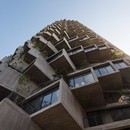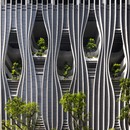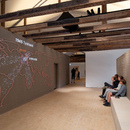Biography
BIG, founded by Bjarke Ingels in 2005, is one of the world’s most advanced studios in the definition of urban scenarios and horizons.BIG has worked on numerous projects all over the world, all sharing a visionary view and an interest in innovative theories about contemporary society and lifestyles.
Its two offices in Copenhagen and New York bring together professionals from all over the world, promoting cultural exchange as a source of wealth in design.
The group’s expertise ranges from architecture to design, from concept creation to engineering.
The studio also explores new disciplines bounding on architecture, stimulating research and coming up with new perspectives on the cities we will live in in years to come. Digital representation technologies are seen not as an end in themselves but as a means of achieving these goals. Society, economics and ecology are the themes dearest to Bjarke Ingels and his team, addressed in every one of his projects.
Ingels began his career working at OMA with Rem Koolhaas; in 2001 he co-founded PLOT (Julien De Smedt and Bjarke Ingels).
In his academic career, Ingels has been visiting professor at Rice University School of Architecture and at the Graduate School of Architecture, Planning and Preservation of Columbia University and visiting professor at Harvard University.
In 2004 he was awarded a Golden Lion at the Biennale in Venice for his Stavanger Concert House, and the following year he won the Forum AID Award for his VM homes.
The Mountain housing development, which made Bjarke Ingels famous all over the world, has received countless awards including the World Architecture Festival Housing Award, the Forum Aid Award and the MIPIM Residential Development Award.
SELECTED PROJECTS
- Danish National Maritime Museum, Kronborg (Denmark), 2013
- Gammel Hellerup Gymnasium, Hellerup (Denmark), 2013
- Expo 2010 Danish Pavilion, Shanghai (China), 2010
- 8 house, Copenhagen (Denmark), 2009
- The Mountain, Copenhagen (Denmark), 2007
- Sjakket Community Building, Copenhagen (Denmark), 2007
- VM houses, Copenhagen (Denmark), 2005
- Psychiatric Hospital, Helsingør (Denmark), 2005
- Maritime Youth House, Copenhagen (Denmark), 2003
- Copenhagen Harbour Bath, Copenhagen (Denmark), 2003
Bjarke Ingels Interview’s
Photo: Danish National Maritime Museum_photograph Luca Santiago Mora
Gammel Hellerup Gymnasium_photograph Jens Lindhe
www.big.dk
Interview
My first question is about the city you live, can you tell me what is your vision of Copenhagen?BJARKE INGELS. When I think about Copenhagen I think about sustainability and in particular how technology does not have to be a downgrade of life quality but rather the way it can improve the quality of life. Sustainability is often associated with sacrifice, in the way you have to give up some of the quality of living in order to be sustainable. However, I think that in Copenhagen there are quite a few examples where sustainability actually increases the quality of life. Par instance in Copenhagen 37% of inhabitants commute by bicycle so we do not spend time in traffic jams and looking to parking places. People just move freely around the city. Also the water in Copenhagen harbour has become so clean that people can swim in it. So in the middle of the harbour we can actually jump in the water and swim. This is the kind of attitude we have applied to some of our work: we have designed a building structure with parking facilities and an apartment building where the parking lot creates a man-made mountain and all the apartments are turned into houses with gardens on a south-facing slope. So people have a penthouse view and they also have a garden where they can run out and play. And in one of our latest projects we actually took a neighbourhood of town houses but with little gardens in front and we designed an urban block so people can actually walk or cycle all the way from the garden to the penthouse. The result is like a three-dimensional urban condition where social space invades the vertical part of the city.
You have an another major ongoing project in Copenhagen, which is the Amager Bakke waste-to-energy plant. This is a good challenge for the city and for the sustainability of the city..
BJARKE INGELS. The main idea represents the ultimate example of sustainability: instead of throwing rubbish in landfills, we recycle 42% of waste and we burn 54% of this waste and use it to produce heat and electricity. As a matter of fact 97% of the homes in Copenhagen don’t spend any energy on heating even though the weather can be cold, because they get all the heat from the excess heat produced by the power station. This project is so big and it is in the middle of the city, in the harbour area. We even proposed to create a ski slope on the roof since we do get snow here and the country is completely flat. We could turn the roof into a man-made ski slope. In winter, people can take a lift to the top of the power station and just ski down for fun all the way to the ground floor.
This is a good example of combination of public space with town utility. How was the project accepted by the citizens?
BJARKE INGELS. Usually when you plan to build a power plant in the middle of the city, you can expect a lot of complaints: people do not want to live next to a power plant but we received email messages from people asking when the project was going to be completed because they were looking forward to skiing!
More recently you won another important international design competition for a new 27.000 m2 cultural complex in Albania, can you tell us more about this project?
BJARKE INGELS. This is a cultural complex. As you’ll probably know, right now there is a little unrest in Tirana because of the upcoming elections so we are eager to see how things will evolve. The project is for a complex with a Museum of Religious Harmony , an Islamic Centre and a Mosque. The basic idea is to integrate public life with the religious space and also with a view to integrate the religion into the city. When we went to Tirana to have a look at the project, we went on weekends, on Fridays and special holidays. And we could see that the current mosque is too small so people praying actually spill out onto the streets. So the intention is to combine the city grid of Tirana with the orientation towards The Mecca. On the ground floor, all the three buildings, are oriented towards The Mecca to create a square in front of the mosque whereas at roof level the building follows the grid of the city streets and walls. The idea is to get these two directions to create a semi-covered outdoor space, almost extending the mosque outward onto the street but also inviting the street and the public space all the way to the mosque, creating a sort of overlap, which is half indoors and half outdoors, half mosque and half Tirana.
You always involve the city in your projects, and you usually deal with social projects, but what do you think is the relationship between architecture and politics?
BJARKE INGELS. I think politics is the process of trying to listen to the demands and desires and concerns of citizens and turn these collective concerns into political reality through representation; in a very similar though more concealed way architecture deals with accommodating the concerns and demands of citizens. So as architects we are at the centre of trying to continuously coordinate the collective effort of making sure that our cities and buildings fit with the way we want to live and in an ideal world that is also what politicians should be doing.
Do you think that architecture is a promotional tool for politics or politics is a tool for an architect to achieve something important in a city?
BJARKE INGELS. I think these two aspects are probably true: sometimes an architectural project can have a promotional significance and but also as architects, we have to get involved with politics because somehow politics shape the reality in which we work. Here in Italy I think for example how strange to see the case of Stefano Boeri, organiser of Festarch and Editor of Abitare, who used to be an architect interested in politics and now he is probably more like a politician interested in architecture. Strangely enough it is like taking the same concern about continually improving people’s daily life and doing it through legislation rather than design and hopefully he can keep on doing both.
Rather difficult I guess. How do you feel when people say you are “l’Enfant terrible” of design and architecture?
BJARKE INGELS. I don’t really know about that! However I think that quite early on in my career I realised I was often more interested in the society rather than in looking at architecture in isolation. Rather than considering architecture as an autonomous art form isolated from the rest of the world, I really see the role of architecture and of architects to be completely involved with the rest of society. As a result sometimes our projects might relate more to people that are not architects because they create possibilities that somehow plug into daily life. For instance in the Danish pavilion in Shanghai there was a bath. The idea was to create a very active architecture where you can walk and cycle through the pavilion and through the exhibitions, you can dip your toes in the pool in the middle. There is a socially-provocative bench that promotes various forms of interaction with the pavilion. There is an art work in the shape of a fountain that also becomes almost like a playground for kids. So in many ways it is an architecture that does not just try to look beautiful or poetic but it really creates possibilities. Some people would argue that creating a ski slope on top of a power plant has nothing to do with architecture but this is somehow the architecture of organising all aspects of human life in new mixtures. As a sort of symbol of humanistic sustainability, it is both economically and ecologically sustainable by turning rubbish into heat and energy but also socially sustainable by turning a power plant into a public park.
Interview by Flores Zanchi
Related Articles: BIG – Bjarke Ingels Group
Related Articles









